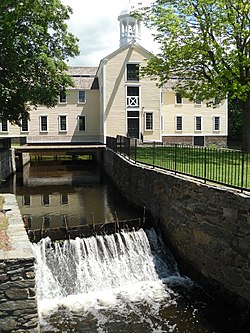Slater Mill Historic Site
|
Old Slater Mill
|
|
 |
|
| Location | Roosevelt Avenue, Pawtucket, Rhode Island |
|---|---|
| Coordinates | 41°52′39″N 71°22′57″W / 41.87750°N 71.38250°WCoordinates: 41°52′39″N 71°22′57″W / 41.87750°N 71.38250°W |
| Area | 4.23 acres (1.71 ha) |
| Built | 1793 |
| NRHP Reference # | 66000001 |
| Significant dates | |
| Added to NRHP | November 13, 1966 |
| Designated NHL | November 13, 1966 |
The Slater Mill is a historic textile mill complex on the banks of the Blackstone River in Pawtucket, Rhode Island, modeled after cotton spinning mills first established in England. It is the first water-powered cotton spinning mill in North America to utilize the Arkwright system of cotton spinning as developed by Richard Arkwright.
Samuel Slater, the mill's founder, apprenticed as a young man in Belper, England with industrialist Jedediah Strutt. Shortly after immigrating to the United States, Slater was hired by Moses Brown of Providence, Rhode Island to produce a working set of machines necessary to spin cotton yarn using water power. Construction of the machines was completed in 1793, as well as a dam, waterway, waterwheel, and mill. Manufacturing was based on Richard Arkwright's cotton spinning system, which included carding, drawing, and spinning machines. Slater initially hired children and families to work in his mill, establishing a pattern that was replicated throughout the Blackstone Valley and known as the "Rhode Island System". It was later eclipsed by Francis Cabot Lowell's Waltham System.
Slater Mill was added to the National Register of Historic Places and designated a National Historic Landmark on November 13, 1966, the first property to be listed on the register. In December 2014, the mill was added to the newly formed Blackstone River Valley National Historical Park.
The original portion of the Slater Mill built in 1793 was six bays long and two stories tall. Several additions were made beginning in 1801, and a second added in 1835. Between 1869 and 1872, a large addition was made to the north end of the mill. Cotton spinning continued until 1895, after which the mill was used for various industrial purposes until 1923. The building had suffered numerous fires in the past, and two fires occurred in 1912 which precipitated awareness of the building and the need for its preservation.
...
Wikipedia
